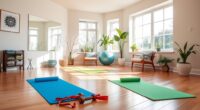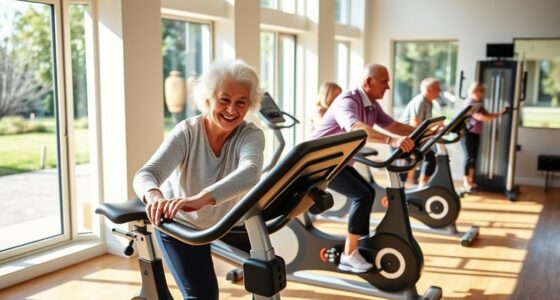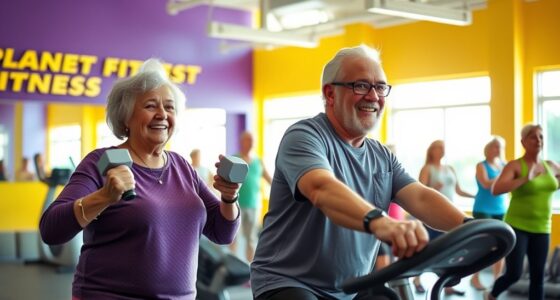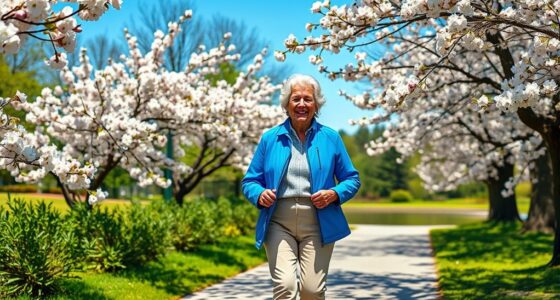An elderly exercise program emphasizes gentle fitness activities that enhance health, strength, and balance every day. Aim for 150 minutes of moderate aerobic exercises weekly, breaking sessions into manageable 10- to 15-minute increments. Include stretching and strength training to maintain muscle and flexibility, and incorporate balance exercises to reduce fall risks. Gentle cardio, like walking or swimming, can easily fit into your routine. Discover more tips and strategies to enrich your exercise journey and overall well-being.
Key Takeaways
- Incorporate gentle cardio activities like walking or swimming for 150 minutes weekly to boost heart health and overall well-being.
- Utilize strength training twice a week with light weights or resistance bands to maintain muscle strength and bone density.
- Engage in daily stretching and balance exercises, such as tai chi, to improve flexibility and reduce the risk of falls.
- Break exercise sessions into manageable 10 to 15-minute increments for consistency and ease of integration into daily routines.
- Seek tailored resources and community programs, like those from the NCOA, for guidance and motivation in establishing an exercise plan.
Importance of Regular Exercise for Seniors
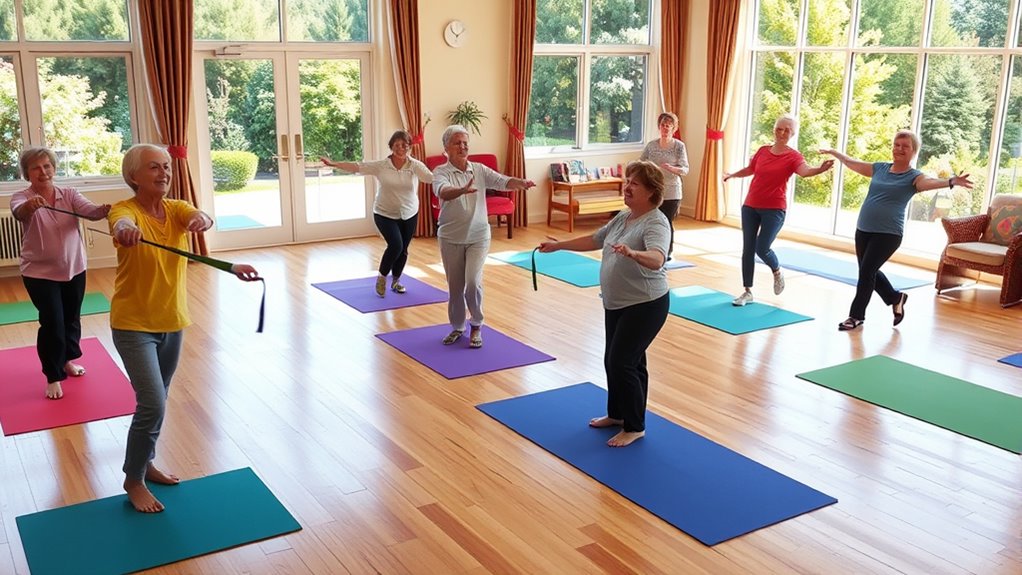
Regular exercise is essential for seniors since it directly impacts both physical and mental health. Engaging in consistent physical activity, like strength training twice a week, helps maintain muscle strength and prevents bone mass loss. This is critical for your independence and mobility. Additionally, participating in activities that support overall wellness can enhance your exercise routine and improve your physical health. Research shows that foods rich in omega-3 fatty acids can also support cognitive function, which is vital for maintaining mental clarity as you age. Furthermore, incorporating dementia medications for the elderly can aid in managing cognitive health effectively. It’s important to remember that emotional stability during exercise can also contribute positively to mental well-being.
Incorporating balance exercises three times a week can greatly improve balance, reducing your risk of falls, which are a leading cause of injury among older adults. Moreover, regular exercise boosts mental health by alleviating symptoms of anxiety and depression, common in your age group. It also enhances cognitive function, contributing to a better quality of life. Furthermore, maintaining healthy eating habits alongside regular exercise can significantly improve overall well-being.
Weekly Exercise Schedule
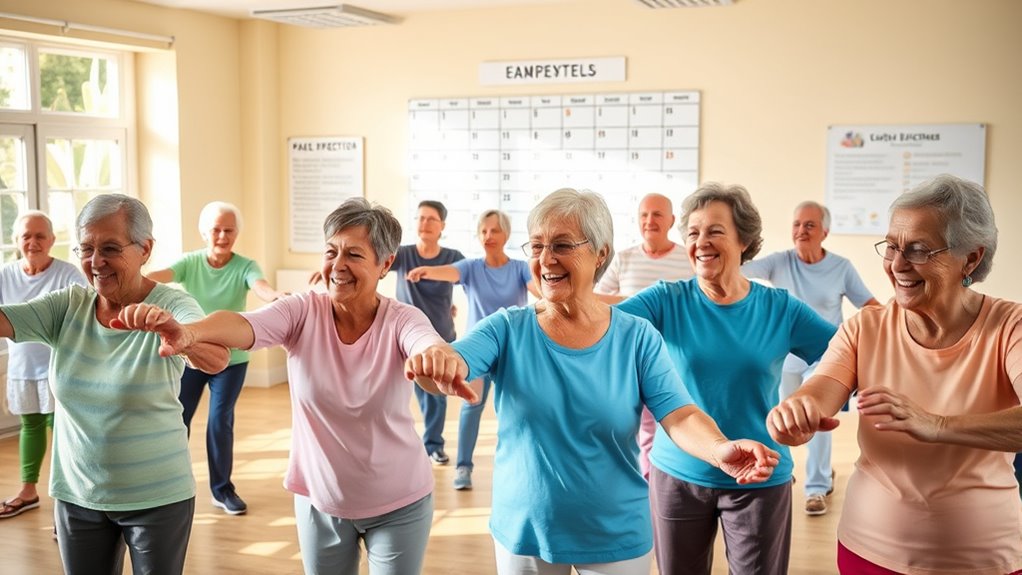
To maintain your health and well-being, establishing a weekly exercise schedule is crucial for seniors. Aim for 150 minutes of moderate aerobic activity each week, breaking it into sessions of 10 to 15 minutes performed two or more times daily. Incorporating outdoor activities, such as camping locations, can provide both exercise and a refreshing change of scenery. Additionally, engaging in social activities can enhance motivation and enjoyment during your fitness journey. Regular physical activity can also promote resilience by helping to reduce stress and improve mood.
Walking, swimming, and cycling are excellent activities to include in your routine. For example, rest on Sundays, then start Mondays with two 15-minute walks, gradually increasing duration and intensity throughout the week. Don’t forget to incorporate balance exercises into your daily routine to reduce the risk of falls. Additionally, having a clear budget plan can help ensure you have the resources to participate in various fitness activities. Remember that being physically active helps build community resilience during times of crisis. Adjust your schedule based on your health conditions, and consult your doctor before starting any new exercise program to guarantee you’re maximizing the health benefits safely.
Strengthening and Stretching Exercises
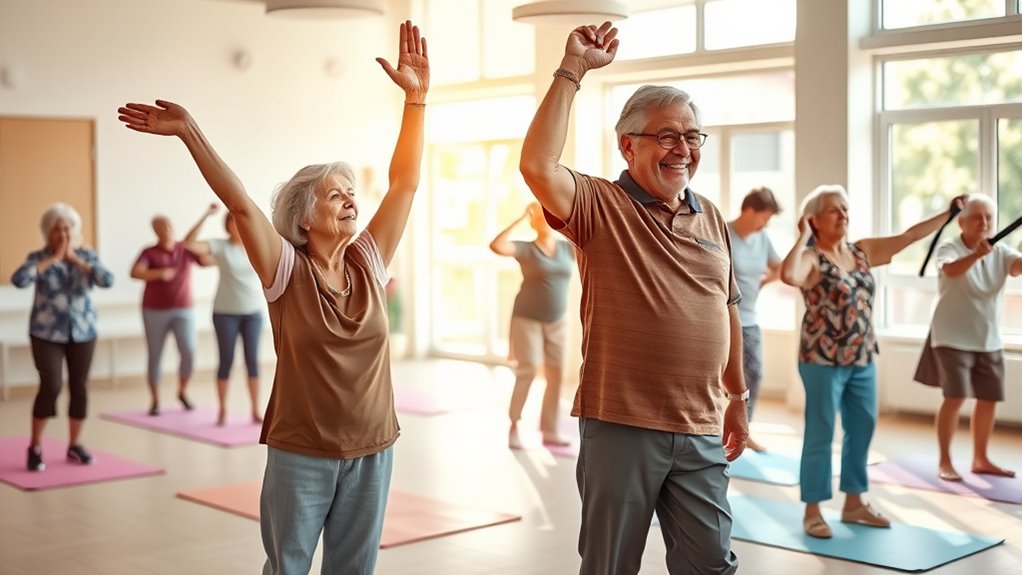
Incorporating strengthening and stretching exercises into your routine is essential for maintaining overall health as you age. These exercises help prevent muscle and bone mass loss, focusing on major muscle groups. Aim for performing sets of 8 to 12 repetitions for strengthening exercises. Daily stretching routines enhance your range of motion and flexibility, with each stretch held for 10 to 30 seconds and repeated 3 to 5 times. Regular physical activity is important to maintain a healthy weight and support overall well-being as you age. Engaging in continuous learning about fitness can further enhance your exercise routine and overall health. Additionally, performing exercises regularly can support optimal usage timing in maintaining an active lifestyle. Incorporating pet therapy as part of your exercise routine can also enhance emotional well-being and reduce feelings of isolation. Engaging in regular dog training activities can also be a fun way to stay active and strengthen your bond with your pet.
| Exercise Type | Benefits |
|---|---|
| Strengthening Exercises | Improve balance, reduce risk of falls |
| Stretching Routines | Enhance flexibility, improve range of motion |
| Home Exercises | No equipment needed, accessible |
| Active Lifestyle | Boosts quality of life |
Regularly practicing these exercises can lead to a healthier, more active lifestyle.
Balance Exercises for Fall Prevention
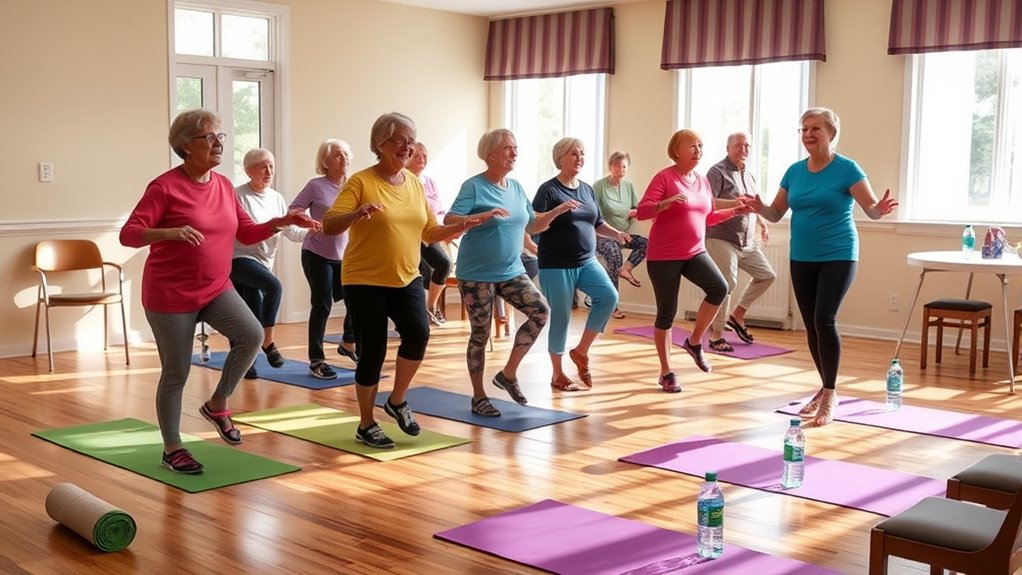
Balance exercises play an essential role in fall prevention for older adults, enhancing coordination and stability. Incorporating simple activities like tai chi, shifting weight, and single-leg balances into your daily routine can greatly lower your fall risk. Additionally, regular audiometric testing can help identify any hearing issues that may affect balance. According to Louisiana alimony laws, maintaining a stable environment is crucial for overall well-being, including physical health. A well-organized space minimizes distractions and encourages mindfulness, which can further support balance and stability. Engaging in regular physical activity, such as regular exercise, can also significantly improve muscle strength and coordination.
Aim to practice these balance exercises at least three times a week for optimal effectiveness. Not only do they improve your stability, but they also strengthen your core, which is vital for maintaining balance during everyday activities. Programs like Tai Ji Quan provide evidence-based interventions that boost mobility and functional strength, further reducing the likelihood of falls. By focusing on balance, you’ll gain confidence in your movements and enhance your overall well-being. Additionally, seeking professional help can also support your journey toward safer living as you navigate exercise routines.
Start today, and take proactive steps toward safer living!
Gentle Cardio Exercises

Gentle cardio exercises, like walking and swimming, are perfect for fitting into your daily routine without overwhelming yourself. You can easily start with short sessions of 10 to 15 minutes, gradually building up to the recommended 150 minutes per week. These low-impact options not only boost your heart health but also enhance your overall well-being. Additionally, incorporating regular physical activity into your routine can significantly improve your energy levels and mental clarity. Engaging in outdoor activities, such as hiking and wildlife observation, can further promote physical fitness while allowing you to enjoy the beauty of nature. Moreover, participating in exercises that focus on color accuracy can help improve coordination and balance. Introducing educational toys can also enhance cognitive skills, making physical activity more engaging and beneficial. Furthermore, gentle exercises can be tailored to individual needs, ensuring they remain accessible and enjoyable for everyone, including older adults.
Low-Impact Options
When it comes to staying active, low-impact cardio exercises are a fantastic choice for older adults looking to improve their health without putting too much strain on their bodies.
Gentle activities like walking, swimming, and cycling help you achieve at least 150 minutes of moderate activity weekly. Walking, whether indoors or outdoors, can enhance your mood and maintain a healthy weight.
Tai chi and yoga not only improve flexibility but also add enjoyment to your routine. Using equipment like static bikes or rowing machines provides low-impact options that build strength and offer convenience for indoor workouts. Additionally, incorporating office chairs for neck pain relief can enhance comfort during workouts, particularly for those who may need to sit for longer periods.
Regular participation in these exercises reduces the risk of chronic diseases and boosts your overall well-being, ensuring a better quality of life.
Daily Routine Integration
Incorporating low-impact cardio exercises into your daily routine can make it easier to meet the recommended 150 minutes of activity each week. You can break these exercises into 10- to 15-minute sessions throughout the day.
Here are some gentle cardio exercises to contemplate:
- Walking or marching in place
- Swimming or water aerobics
- Cycling on a stationary bike
- Tai chi for balance
- Walking backwards to improve coordination
These activities not only help prevent falls but also enhance your overall health.
By consistently performing these exercise routines, you’ll boost your energy levels and mood while enjoying the benefits of staying active.
Creating a Personalized Exercise Plan
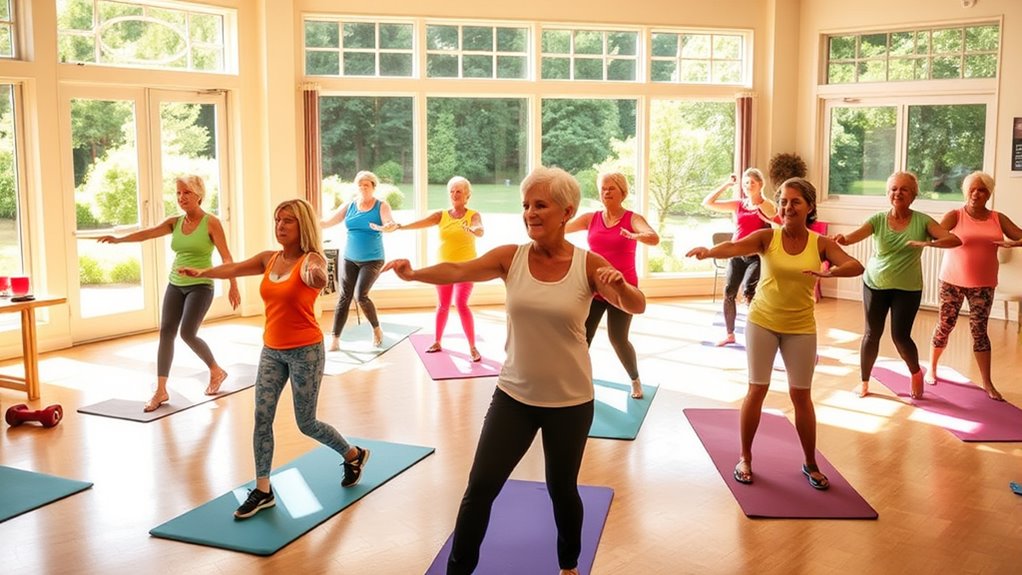
Creating a personalized exercise plan is essential for older adults to stay active and healthy, as it guarantees that the activities align with individual abilities and health conditions.
Start by incorporating daily stretching and balance exercises to enhance flexibility and stability. For strength training, use a sturdy chair and lift your left foot while keeping your feet hip-width apart to strengthen your lower body.
Aim for at least 150 minutes of moderate aerobic activity each week, breaking sessions into manageable 10- to 15-minute increments. Regularly assess your progress and adjust your exercise plan for gradual progression.
This approach assures your routine remains safe and effective, promoting consistency and helping you achieve your fitness goals while enjoying the benefits of an active lifestyle.
Health and Wellness Resources for Seniors
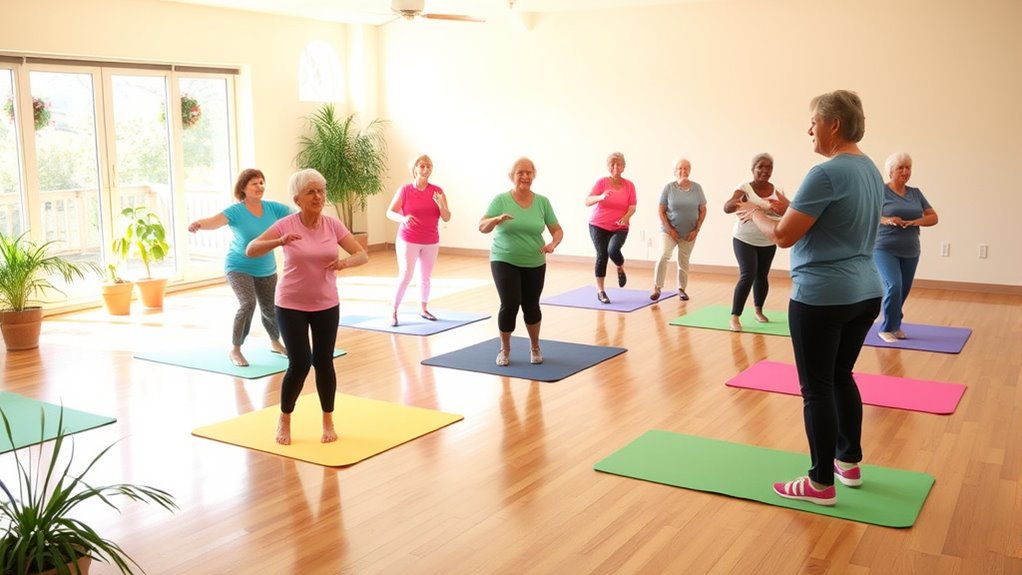
Finding the right resources can greatly enhance your exercise routine and overall wellness as you age. Here are some valuable tools to take into account:
- National Council on Aging (NCOA): Offers tailored resources for seniors and community organizations.
- CDC Guidelines: Recommends 150 minutes of moderate-intensity aerobic activity weekly for older adults.
- Arthritis Foundation’s “Walk with Ease”: Helps create personalized walking plans to boost physical activity.
- Federal Funding: Supports initiatives that improve quality of life and promote independence among seniors.
- Local Community Programs: Access evidence-based exercise programs to guarantee proper guidance for your physical activity.
Using these resources can greatly assist your health and wellness journey, making exercise more enjoyable and effective.
Frequently Asked Questions
What Is the Best Fitness Program for Seniors?
The best fitness program for you as a senior should blend aerobic, strength-training, and balance exercises. Aim for at least 150 minutes of moderate activity each week.
Programs like EnhanceFitness and Tai Chi can help improve flexibility, coordination, and reduce fall risks.
Group exercises not only boost your physical health but also enhance social connections, which is essential for mental well-being.
Always consult with a healthcare professional to tailor your regimen to your abilities.
What Exercise Should a 70 Year Old Do Every Day?
You’d think a 70-year-old should just relax and take it easy, right? Well, not quite!
Every day, you should focus on activities that keep you moving and engaged. Aim for 10 to 15 minutes of moderate aerobic exercise, like walking or cycling.
Add in strength training twice a week, practice balance exercises daily, and don’t forget gentle stretching.
These activities not only boost your health but also keep life enjoyable and vibrant!
What Is the Number 1 Exercise to Increase Balance in Seniors?
If you’re looking to increase balance, tai chi’s your best bet. This gentle exercise promotes controlled movements that enhance your body awareness and stability.
Studies show that participating in tai chi can reduce fall risk by 55%, making it a smart choice for seniors. Practicing regularly, ideally 1-2 times a week, not only improves your balance and coordination but also boosts mental health and overall well-being.
Give it a try!
Should Seniors Exercise Every Day?
Yes, seniors should exercise every day! Engaging in daily physical activity boosts your overall health and enhances your balance, strength, and flexibility.
You can break your routines into manageable 10- or 15-minute sessions, making it easier to fit into your schedule. Whether it’s walking, swimming, or tai chi, consistency is key.
Just remember to consult your healthcare provider before starting any new exercise to guarantee it’s safe and suitable for you.
Conclusion
Incorporating gentle fitness into your daily routine can enhance your strength, boost your balance, and elevate your overall well-being. By dedicating time to regular exercise, you’re not just improving your physical health; you’re also nurturing your mental and emotional wellness. So, embrace the journey, explore different activities, and listen to your body. Remember, every small step counts, every gentle movement matters. Start today, stay active, and enjoy a happier, healthier life as you age gracefully!

